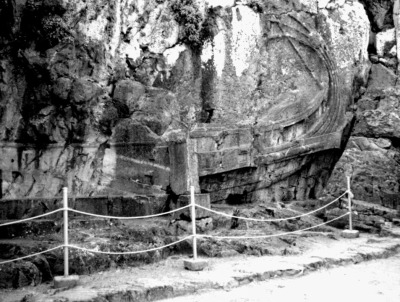Carving of a triemolia (Rhodian ship), 2nd century BC, Lindos. Carved into the rocks on the route to the Acropolis at Lindos. On the bow there stood a statue of General Hagesander Mikkion, by sculptor Pythocritos. Dates from c 180 -170 b.c.
Most easterly of the islands in the Aegean, situated off the coast of Caria in Asia Minor. From the time of Vespasian (ruled 69-79 A.D.), Rhodes, known as Rhodus, was attached to the province of ASIA. The island had a long history of excellent relations with Rome, helping in the Macedonian and Mithridatic Wars. Supporting the cause of Julius Caesar during the Civil War, Rhodes was plundered mercilessly by Gaius Cassius in 42 B.C. but was richly rewarded by Augustus for its loyalty. Starting in 6 B.C., Tiberius took up residence on the island in a self-imposed exile from the disappointments of Rome; he would depart to become adopted by Augustus in 4 A.D. Because of their act of crucifying several Roman citizens, the Rhodians were deprived of their independence in 44 A.D. by Claudius. Appealing to Nero in 53, they were given their own government again, although prosperity was never actually attained. An earthquake in 155 A.D. flattened most of the island, and henceforth it remained one of the least developed corners of the Empire.
Though never large, this should be the best fleet of the ancient period. Excellent seamanship coupled with generally heavier types than the Carthaginians. Superior Rhodian naval architecture was a state secret, with the sentence death passed on unauthorized persons in military shipyards. Frequently allied to Rome, the Rhodians provided the major check on pirate activity in the Mediterranean. When Roman policy later diverted trade revenue from Rhodes destroying the economic basis of the fleet, the Mediterranean largely fell under the control of pirates.
Ally of Rome
By the late third century BC, the expansionist ambitions of Philip V of Macedon threatened Rhodes and in 208 BC, they joined other Greek states in an embassy to mediate with him;14 an exercise repeated in the following year. The First Macedonian War ended in 205 BC, with Rhodes’ sympathies leaning towards Rome who, having suppressed Illiyrian piracy and removed the Carthaginian’s power, had provided stable conditions for Rhodes’ trade in the West. The Rhodian’s concerted action against Crete and its pirates also alienated Philip, as president of the Cretan confederacy.15 Philip’s increasing aggression and build-up of naval power led to open war between them in 202 BC.
The following spring, Philip’s fleet seized the Cyclades and Samos. Rhodes sent a fleet of thirty ships to Lade, where they were bested by Philip’s greater numbers in a brief batrle, losing two quinqueremes. They did subsequently recover most of the Cyclades. Pergamum, also threatened, now joined Rhodes in the war, their joint fleets meeting and defeating that of Philip at the battle of Chios.16 A further battle near Miletus resulted in a Pyrrhic victory for Philip and cost him nearly half of his fleet. Rhodes and Pergamum appealed to Rome for help and with the addition of a Roman fleet of thirty-eight ships and those of the allied Athenians, Philip was unable to mount any further challenge at sea. The allied fleets harried enemy coasts, with the Rhodians blockading Philip’s ships at Volos (Demetrios) until the end of the war in 197 BC. In 194 BC, Rhodes sent eighteen ships to join those of Pergamum in defeating the bellicose King Nabis of Sparta.
